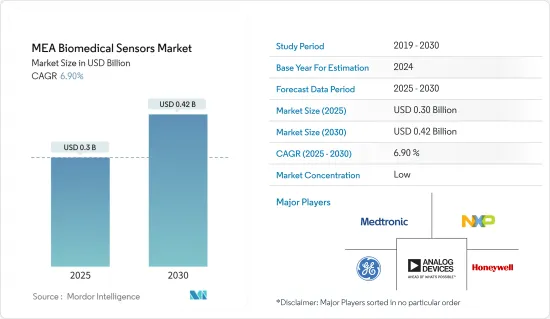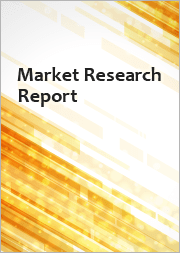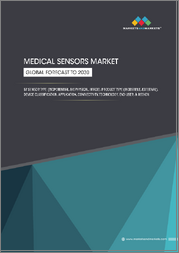
|
시장보고서
상품코드
1640353
중동 및 아프리카의 바이오메디컬 센서 시장 - 점유율 분석, 산업 동향, 성장 예측(2025-2030년)MEA Biomedical Sensors - Market Share Analysis, Industry Trends & Statistics, Growth Forecasts (2025 - 2030) |
||||||
중동 및 아프리카의 바이오메디컬 센서 시장 규모는 2025년 3억 달러, 2030년 4억 2,000만 달러로 추정되며, 예측기간(2025-2030년)중 CAGR은 6.9%에 달할 것으로 예측되고 있습니다.

바이오메디컬 센서는 불규칙한 측정값을 찾았을 때 경고를 보내거나 혈액의 유해물질을 확인하거나 순환계에 약물을 침투시키도록 만들어졌습니다. 이러한 특성을 가진 센서 개발에 대한 투자는 시장 조사의 중요한 촉진요인입니다.
주요 하이라이트
- 바이오메디컬 센서 시장은 위험한 환경에서 수요 증가, 자연 재해에 의한 상황에서의 이용, 당뇨병 환자와 심장병 환자의 의료 부문에서 수요 증가, 환자의 이식 모니터링 등이 견인하고 있습니다. 기술의 진보로 나노기술과 마이크로기술을 이용한 바이오메디컬 센서의 제조가 가능해졌으며, 작고 견고하며 스마트하고 비용 효율적인 것이 가능해졌습니다. 환자의 건강 상태 이상을 조기에 발견하는 것은 삶의 질을 향상시키는 데 기여합니다.
- 항균제 내성, 생활습관의 혼란, 음주, 흡연은 당뇨병을 포함한 생활습관병의 유병률 증가의 원인이 되고 있습니다. IDF Diabetes Atlas에 따르면 중동과 북아프리카에서는 성인 6명 중 1명(7,300만 명)이 당뇨병을 앓고 있다고 합니다. 또한 성인 당뇨병 환자 수는 2030년까지 9,500만 명, 2045년까지 1억 3,600만 명에 이를 것으로 예측됩니다. 그 결과, 일상적인 건강 모니터링을 위한 바이오메디컬 센서의 필요성이 높아지고 있습니다.
- 의료에 대한 의식이 높아짐에 따라 안전을 높이기 위해 건강 상태를 감지하고 사용자에게 피드백을 제공할 수 있는 센서 기술 및 모니터링 장비의 필요성이 높아져 조사 대상 시장의 성장을 더욱 촉진할 수 있습니다.
- 바이오메디컬 센서는 구명 상황에서 중요한 역할을 하는 강한 전자기장에 의한 환자의 안전성과 쾌적성, 고효율로 데이터 레이트를 향상시킨 외부 부품에서 내부 부품으로의 에너지 전송, 한정된 계산과 데이터 스토리지, 초저에너지 소비 등 특유의 과제에 직면하고 있습니다.
- 러시아 우크라이나 전쟁은 각종 센서를 포함한 반도체나 전자 부품을 생산하기 위한 원료의 중요한 공급원인 반도체나 전자 부품공급 체인에 영향을 주고 있습니다. 분쟁은 공급망을 혼란스럽게 하여 이러한 재료의 부족과 가격 상승을 일으키고 생체 메디컬 센서 제조업체에 영향을 미치며 최종 사용자의 비용 상승으로 이어질 수 있습니다.
중동 및 아프리카의 바이오메디컬 센서 시장 동향
피트니스 장비 수요 증가가 시장을 견인
- 당뇨병과 고혈압과 같은 생활 습관병의 이환율과 유병률은 사람들의 좌식 라이프 스타일 때문에 예측 기간 동안 상승할 것으로 예측됩니다. 이러한 질병 중 일부는 혈당과 혈압과 같은 여러 생리학적 요인을 지속적으로 모니터링해야 합니다. 이를 통해 의료 데이터를 휴대용 의료기기에 통합하고 임상의에게 제공함으로써 실시간 데이터 액세스 및 오류 감소가 가능합니다.
- 게다가, 비전염성 질환으로 인한 사망률 증가는 심각한 우려 물질이기 때문에 개인에 의한 모니터링과 관리에 더욱 주력해야 합니다. 이는 웨어러블 의료기기와 연구 산업 수요를 장기적으로 끌어올릴 것으로 예상됩니다. WHO에 따르면 아랍에미리트(UAE)에서는 4개의 주요 NCDs에 의해 연간 약 4,800명이 사망하고 있으며, NCDs에 의해 70세까지 사망할 확률은 약 5명 중 1명입니다.
- 웨어러블 생물의료센서는 최근 관심을 모으고 있으며, 웨어러블 건강기술 부문에서는 눈부신 개발입니다. 이 센서는 신체에 장착할 수 있는 디지털 기기로, 혈당, 혈압, 심박수 및 기타 생체 데이터를 지속적이고 지속적으로 계산할 수 있습니다.
- 또한 2023년 9월 Emirates Global Aluminum은 웨어러블 기술 플랫폼인 Kenzen의 사용을 확대하고 여름에 '더위를 날려버리는' 350명의 직원 자원봉사자에게 제공했다고 발표했습니다. Kenzen의 웨어러블 기술은 체온, 심박수, 활동량 및 기타 신체 지표를 지속적으로 보고하고 사용자와 EGA 안전 팀이 징후를 인식하여 신체의 열 스트레스를 피할 수 있게 함으로써 아랍에미리트(UAE)의 야외 근로자를 보호할 가능성을 갖고 있습니다.
- 또한 국제 당뇨병 연합에 따르면 중동 및 아프리카에서는 당뇨병 환자가 증가하고 있으며 2045년까지 중동 및 아프리카 당뇨병 환자는 136명이 될 것으로 예상되고 있습니다.
- 만성 질환의 빈도 상승과 사망률 상승은 개인과 정부 기관 모두에게 심각한 우려 요인입니다. 그 결과, 의료 종사자는 환자의 지속적인 원격 모니터링을 포함한 맞춤형 치료를 제공할 수 있게 되었습니다. 또한 일상생활에 지장을 초래하지 않고 최대 24시간 장착할 수 있습니다. 이와 같이 웨어러블 의료기기에는 많은 장점이 있기 때문에 웨어러블 의료기기 수요와 시장은 예측기간 동안 확대될 것으로 예상됩니다.
- 사물인터넷(Internet of Things)의 보급에 따라 산업은 확대될 것으로 예상됩니다. 또한 신기술의 등장과 합리적인 가격으로 고객에게 지지되는 혁신적인 제품의 채용도 중동 및 아프리카에서 피트니스 트래커 수요를 촉진하고 있습니다. 운동이나 스포츠 활동에 참가할 때, 걸은 걸음수, 심박수, 수면 시간, 소비 칼로리 등을 기록 및 모니터링하는 경향이 강해지고 있는 것도, 중동 및 아프리카에서 피트니스 트래커 수요를 높일 것으로 예상됩니다.
현저한 성장이 기대되는 사우디아라비아
- 사우디아라비아에서는 생활 습관병의 유병률이 증가하고, 1차 의료, 예방 의료, 전문 클리닉에 대한 주목도가 높아지고 있기 때문에 생체 압력 센서 수요에 박차가 걸릴 것으로 예상됩니다. 사우디아라비아에서는 민간 병원, 클리닉, 디지털 헬스 서비스의 개발이 진행되고 있으며, 모니터링 및 진단 기기의 개발이 더욱 확대되고 있습니다.
- 사우디아라비아는 최근 대규모 투자로 의료 부문이 크게 성장하고 있습니다. 정부 지출 증가와 민간 부문의 참여는 의료 인프라의 질을 향상시키고 수요의 급증에 대응하고 있습니다.
- 고령화와 장기화하는 만성 질환으로 인한 원격 환자 모니터링 솔루션 수요 증가는 시장 성장을 뒷받침하는 주요 요인입니다. 특히 재활클리닉, 정신의료시설, 투석센터 등에서는 진단 및 모니터링 기기 수요가 늘고 있으며, 이 시장의 벤더에게 새로운 비즈니스 기회를 가져오고 있습니다.
- 통계총국(사우디아라비아)에 따르면 2023년 사우디아라비아 북부 국경 성인의 55%가 정기 건강검진을 받고 있습니다. 13개 지역 중 10개 지역의 성인의 40-49%가 정기 건강 진단을 받고 있었습니다. 성인의 정기 건강진단 진찰률이 가장 낮은 지역은 자잔으로 35%였습니다.
- 사우디아라비아의 비전 2030은 의료를 개발의 중요한 기둥 중 하나로 정의하고 의료에 대한 접근성과 품질을 향상시키기위한 목표와 전략을 수립합니다. 첨단 인프라 구축은 매우 중요하며, 정부는 민간 부문에 약 660억 달러의 투자를 요청하고 있습니다. 이러한 이유로 사우디아라비아는 중동에서 가장 유망한 의료 시장이 되었습니다.
- 국립보건실(NIH)에 따르면, 사우디아라비아에서는 비전염성 질환이 전체 사망의 73%를 차지하고 있습니다. NCD에 의한 사망의 주요 원인은 심혈관 질환으로, 전체의 37%를 차지하고, 이어서 암이 10%, 당뇨병이 3%, 호흡기 질환이 3%, 기타 NCD가 20%가 되고 있습니다. 사우디아라비아는 생활습관병이나 당뇨병의 예방과 치료를 위해 앞으로도 지출을 늘려 나갈 것을 목표로 하고 있습니다. 또한 사우디아라비아의 의료기기 시장은 20억 달러로 추정되며 연간 약 10%로 성장하고 있습니다.
중동 및 아프리카의 바이오메디컬 센서 산업 개요
중동 및 아프리카의 바이오메디컬 센서 시장은 세계 기업과 중소기업 모두가 존재하기 때문에 매우 세분화되어 있습니다. 이 시장의 주요 기업으로는 NXP Semiconductors, GE Healthcare Technologies, Inc., Honeywell International, Analog Devices, Inc., Medtronic 등이 있습니다. 시장 진출기업은 제품 라인업을 강화하고 지속 가능한 경쟁 우위를 얻기 위해 제휴 및 인수와 같은 전략을 채택하고 있습니다.
- 2023년 10월 사우디아라비아 투자부는 국내외 7개 기업과 총 10억 7,000만 달러의 8개 MoU에 서명했습니다. 이러한 합의는 스텐트, 봉합사 및 센서를 포함한 첨단 의료기기공급 체인의 현지화로 이어집니다.
- 2023년 8월, GE Healthcare는 FDA가 병원이 중요한 징후를 지속적으로 모니터링하고 환자가 병동을 돌아다닐 수 있도록 Portrait VSM 생명 신호 모니터를 승인했다고 발표했습니다. 환자가 장착한 무선 센서는 Portrait 장치의 스마트폰 모니터와 결합됩니다.
기타 혜택
- 엑셀 형식 시장 예측(ME) 시트
- 3개월간의 애널리스트 서포트
목차
제1장 서론
- 조사의 전제조건과 시장 정의
- 조사 범위
제2장 조사 방법
제3장 주요 요약
제4장 시장 인사이트
- 시장 개요
- 산업의 매력 - Porter's Five Forces 분석
- 신규 진입업자의 위협
- 구매자의 협상력
- 공급기업의 협상력
- 대체품의 위협
- 경쟁 기업간 경쟁 관계의 강도
- 공급망 분석
- 거시 경제 동향이 시장에 미치는 영향
제5장 시장 역학
- 시장 성장 촉진요인
- 피트니스 장비에 대한 수요 증가
- 진단에 대한 지출 증가
- 시장 성장 억제요인
- 시스템의 고비용
제6장 시장 세분화
- 유형별
- 유선
- 무선
- 센서 유형별
- 온도
- 압력
- 이미지 센서
- 생화학 센서
- 관성 센서
- 모션 센서
- 심전도(ECG)
- 산업별
- 제약
- 의료
- 국가별
- 사우디아라비아
- 남아프리카
- 아랍에미리트(UAE)
제7장 경쟁 구도
- 기업 프로파일
- NXP Semiconductors
- GE HealthCare Technologies Inc.
- Honeywell International Inc.
- Analog Devices Inc.
- Medtronic
- Smiths Medical
- STMicroelectronics NV
- TE Connectivity
- Pinnacle Technology Inc.
- Sensirion AG
- RESONETICS
제8장 투자 분석
제9장 시장의 미래
JHS 25.02.10The MEA Biomedical Sensors Market size is estimated at USD 0.30 billion in 2025, and is expected to reach USD 0.42 billion by 2030, at a CAGR of 6.9% during the forecast period (2025-2030).

Biomedical sensors are made to send out alerts when they spot irregular readings, check for toxic substances in the blood, or infiltrate drugs right into the circulatory system. Investments in creating sensors with these characteristics are vital drivers of the market studied.
Key Highlights
- The biomedical sensors market is driven by the expanded demand in hazardous environments, utilization in situations resulting from natural disasters, augmented demand in the healthcare sector for diabetic and heart patients, and implanted monitoring of the patients. Technological advancements have made it possible to build biomedical sensors using nano and microtechnology, making them small, robust, smart, and cost-effective. The early detection of irregularities in the health status of the patients will contribute to a better quality of life.
- Antimicrobial resistance, poor lifestyles, alcohol consumption, and smoking contribute to the increased prevalence of lifestyle-related disorders, including diabetes. According to IDF Diabetes Atlas, 1 in 6 adults (73 million) live with diabetes in the Middle East and North Africa. Furthermore, the number of adults with diabetes is predicted to reach 95 million by 2030 and 136 million by 2045. As a result, the requirement for biomedical sensors for routine health monitoring is growing.
- The growing awareness concerning healthcare has increased the need for sensor technologies and monitoring appliances that can sense and deliver feedback to users about their health status for increased safety, which may further drive the growth of the market studied.
- Even though biomedical sensors play a significant role in life-saving situations, they face specific challenges, such as patient safety and comfort due to strong electromagnetic fields, transferring energy from external to inner parts with high efficiency and increased data rates, limited computation and data storage, and ultra-low energy consumption.
- The Russia-Ukraine War is impacting the supply chain of semiconductors and electronic components, being a significant supplier of raw materials for producing semiconductors and electronic components, including various sensors. The dispute has disrupted the supply chain, causing shortages and price increases for these materials, impacting biomedical sensor manufacturers and potentially leading to higher costs for end users.
MEA Biomedical Sensors Market Trends
Growing Demand for Fitness Devices to Drive the Market
- The incidence and prevalence of lifestyle-related illnesses, such as diabetes and hypertension, are anticipated to rise over the forecast period due to the sedentary lifestyle of people. Several physiological factors, such as blood sugar levels and blood pressure, should be continuously monitored in some of these disorders. This enables the integration of healthcare data with portable medical equipment, which may then be provided to clinicians for real-time data access and error reduction.
- Furthermore, the rising death rate from noncommunicable illnesses is a significant source of concern, necessitating a greater focus on tailored monitoring and care. This is expected to boost demand for wearable medical devices and the research industry in the long run. According to WHO, the four main NCDs are causative of the demise of around 4,800 people in the UAE annually, and the chance of dying before age 70 from NCDs is nearly one in five.
- Wearable biomedical sensors are gaining interest nowadays, and it is a remarkable development in the sector of wearable health technology. These sensors are digital devices that can be worn on the body and allow blood glucose levels, blood pressure, heartbeat rate, and other biometric data to be calculated continuously and constantly.
- Furthermore, in September 2023, Emirates Global Aluminum announced that it had expanded the use of Kenzen, a wearable technology platform, to 350 employee volunteers to "Beat the Heat" in the summer. Kenzen's wearable technology has the potential to protect outdoor workers in the UAE by continuously reporting body temperature, heart rate, activity, and other body indicators, allowing both the user and EGA's safety team to avoid heat stress in the body by recognizing signs.
- In addition, according to the International Diabetes Federation, the number of people with diabetes is increasing in the Middle East and Africa, and by 2045, MENA is expected to have 136 people with diabetes.
- The rising frequency of chronic diseases, as well as rising death rates, is a significant source of concern for both individuals and government agencies. As a result, healthcare practitioners can provide tailored care that includes ongoing and remote patient monitoring. These can also be worn for up to 24 hours without interfering with daily activities. As a result of the numerous benefits it provides, the demand for wearable medical devices, as well as the studied market, is expected to increase over the projection period.
- The industry is expected to expand with the rise in popularity of the Internet of Things. The advent of new technologies and the introduction of innovative products in favor of customers at reasonable rates are also driving demand for fitness trackers in the Middle East and Africa. The growing trend of recording and monitoring the number of steps walked, heart rate, sleep duration, and calories burned when exercising or participating in sports activities is expected to enhance the demand for fitness trackers in the Middle East and Africa.
Saudi Arabia Expected to Witness Significant Growth
- The increasing prevalence of lifestyle disease and growing focus on primary healthcare, preventative care, and specialized clinics would fuel the demand for biomedical pressure sensors in Saudi Arabia. The country is witnessing increased development of private hospitals, clinics, and digital health services, further expanding the deployment of monitoring and diagnostics devices.
- Saudi Arabia has experienced significant growth in its healthcare sector due to large investments in recent years. Increased government spending and private sector involvement have improved the quality of healthcare infrastructure to meet surging demand.
- Rising demand for remote patient monitoring solutions due to the aging population and long-lasting chronic diseases are the major factors propelling the market growth. The demand for diagnostics and monitoring devices has been growing, especially in rehabilitation clinics, mental healthcare facilities, and dialysis centers, offering new opportunities to the vendors in the market.
- According to the General Authority for Statistics (Saudi Arabia), in 2023, 55% of adults in Northern Borders in Saudi Arabia had periodic health examinations. Between 40 and 49% of adults in 10 of the 13 regions had regular health check-ups. Jazan was the region with the least share of periodic health examinations among adults, at 35%.
- Saudi Arabia's Vision 2030 defines healthcare as one of the critical pillars of development and sets goals and strategies to improve healthcare access and quality. Building advanced infrastructure is critical, and the government has asked the private sector to invest approximately USD 66 billion to make it happen. This makes Saudi Arabia the most promising healthcare market in the Middle East.
- According to the National Institute of Health (NIH), in Saudi Arabia, non-communicable diseases account for 73% of all deaths. Cardiovascular diseases are the leading cause of NCD deaths, accounting for 37% of total deaths, followed by cancer at 10%, then diabetes at 3%, respiratory diseases at 3%, and other NCDs at 20%. The country aims to continue to increase its spending to prevent and treat lifestyle disorders and diabetes. In addition, the Saudi medical equipment market has an estimated value of USD 2 billion and is growing annually at approximately 10%.
MEA Biomedical Sensors Industry Overview
The Middle East and Africa biomedical sensors market is highly fragmented due to the presence of both global players and small and medium-sized enterprises. Some of the major players in the market are NXP Semiconductors, GE HealthCare Technologies, Inc., Honeywell International Inc., Analog Devices, Inc., and Medtronic. Players in the market are adopting strategies such as partnerships and acquisitions to enhance their product offerings and gain sustainable competitive advantage.
- In October 2023, the Ministry of Investment Saudi Arabia signed eight MoUs, valued at USD 1.07 billion, with seven international and local companies. These agreements will lead to the localization of the supply chain for advanced medical devices, encompassing stents, sutures, and sensors.
- In August 2023, GE HealthCare announced that the FDA cleared its Portrait VSM vital signs monitor, which allows hospitals to continuously monitor critical signs and enable patients to walk around their wards. Wireless sensors that the patients wear are combined with a smartphone-style monitor in the Portrait device.
Additional Benefits:
- The market estimate (ME) sheet in Excel format
- 3 months of analyst support
TABLE OF CONTENTS
1 INTRODUCTION
- 1.1 Study Assumptions and Market Definition
- 1.2 Scope of the Study
2 RESEARCH METHODOLOGY
3 EXECUTIVE SUMMARY
4 MARKET INSIGHTS
- 4.1 Market Overview
- 4.2 Industry Attractiveness - Porter's Five Forces Analysis
- 4.2.1 Threat of New Entrants
- 4.2.2 Bargaining Power of Buyers
- 4.2.3 Bargaining Power of Suppliers
- 4.2.4 Threat of Substitute Products
- 4.2.5 Intensity of Competitive Rivalry
- 4.3 Supply Chain Analysis
- 4.4 Impact of Macroeconomic Trends on the Market
5 MARKET DYNAMICS
- 5.1 Market Drivers
- 5.1.1 Growing Demand for Fitness Devices
- 5.1.2 Increasing Spending on Diagnostics
- 5.2 Market Restraints
- 5.2.1 High Costs of the Systems
6 MARKET SEGMENTATION
- 6.1 By Type
- 6.1.1 Wired
- 6.1.2 Wireless
- 6.2 By Sensor Type
- 6.2.1 Temperature
- 6.2.2 Pressure
- 6.2.3 Image Sensors
- 6.2.4 Biochemical
- 6.2.5 Inertial Sensors
- 6.2.6 Motion Sensors
- 6.2.7 Electrocardiogram (ECG)
- 6.3 By Industry
- 6.3.1 Pharmaceutical
- 6.3.2 Healthcare
- 6.4 By Country
- 6.4.1 Saudi Arabia
- 6.4.2 South Africa
- 6.4.3 United Arab Emirates
7 COMPETITIVE LANDSCAPE
- 7.1 Company Profiles
- 7.1.1 NXP Semiconductors
- 7.1.2 GE HealthCare Technologies Inc.
- 7.1.3 Honeywell International Inc.
- 7.1.4 Analog Devices Inc.
- 7.1.5 Medtronic
- 7.1.6 Smiths Medical
- 7.1.7 STMicroelectronics NV
- 7.1.8 TE Connectivity
- 7.1.9 Pinnacle Technology Inc.
- 7.1.10 Sensirion AG
- 7.1.11 RESONETICS

















